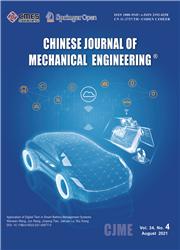高刚度闭环单元全解耦三平移并联机构的类型综合
IF 4.5
2区 工程技术
Q1 Engineering
引用次数: 0
摘要
摘要针对现有全解耦并联机构刚度弱的问题,基于螺旋理论,提出了一种闭环单元高刚度全解耦三平移并联机构的综合方法。首先,给出了永磁转子完全解耦的新判据:永磁转子的传动扳手螺旋矩阵与输出扭矩螺旋矩阵的倒数乘积为对角矩阵,且主对角上的所有元素均为非零常数;传动扳手螺钉的形式由标准确定。其次,根据其与传动扳手螺钉的关系,得到驱动螺钉和非驱动螺钉的形式。基本解耦分支由上述驱动螺钉和非驱动螺钉组合而成。最后,研究了一种闭环单元构造方法,使解耦机构能更好地应用于高刚度场合。在基本解耦分支中构建闭环单元,生成高刚度完全解耦的3T PM。运动学和刚度分析表明,雅可比矩阵为对角矩阵,且刚度明显高于耦合机构的刚度,验证了所提综合方法的正确性。该方法合成的机构在汽车耐久性试验平台上具有良好的应用前景。本文章由计算机程序翻译,如有差异,请以英文原文为准。
Type Synthesis of Fully Decoupled Three Translational Parallel Mechanism with Closed-Loop Units and High Stiffness
Abstract In order to solve the problem of weak stiffness of the existing fully decoupled parallel mechanism, a new synthesis method of fully decoupled three translational (3T) parallel mechanisms (PMs) with closed-loop units and high stiffness is proposed based on screw theory. Firstly, a new criterion for the full decoupled of PMs is presented that the reciprocal product of the transmission wrench screw matrix and the output twist screw matrix of PMs is a diagonal matrix, and all elements on the main diagonal are nonzero constants. The forms of the transmission wrench screws are determined by the criterion. Secondly, the forms of the actuated and unactuated screws can be obtained according to their relationships with the transmission wrench screws. The basic decoupled limbs are generated by combination of the above actuated and unactuated screws. Finally, a closed-loop units construction method is investigated to apply the decoupled mechanisms in a better way on the high stiffness occasion. The closed-loop units are constructed in the basic decoupled limbs to generate a high-stiffness fully decoupled 3T PM. Kinematic and stiffness analyses show that the Jacobian matrix is a diagonal matrix, and the stiffness is obviously higher than that of the coupling mechanisms, which verifies the correctness of the proposed synthesis method. The mechanism synthesized by this method has a good application prospect in vehicle durability test platform.
求助全文
通过发布文献求助,成功后即可免费获取论文全文。
去求助
来源期刊

Chinese Journal of Mechanical Engineering
ENGINEERING, MECHANICAL-
CiteScore
5.60
自引率
4.80%
发文量
3097
审稿时长
8 months
期刊介绍:
Chinese Journal of Mechanical Engineering (CJME) was launched in 1988. It is a peer-reviewed journal under the govern of China Association for Science and Technology (CAST) and sponsored by Chinese Mechanical Engineering Society (CMES).
The publishing scopes of CJME follow with:
Mechanism and Robotics, including but not limited to
-- Innovative Mechanism Design
-- Mechanical Transmission
-- Robot Structure Design and Control
-- Applications for Robotics (e.g., Industrial Robot, Medical Robot, Service Robot…)
-- Tri-Co Robotics
Intelligent Manufacturing Technology, including but not limited to
-- Innovative Industrial Design
-- Intelligent Machining Process
-- Artificial Intelligence
-- Micro- and Nano-manufacturing
-- Material Increasing Manufacturing
-- Intelligent Monitoring Technology
-- Machine Fault Diagnostics and Prognostics
Advanced Transportation Equipment, including but not limited to
-- New Energy Vehicle Technology
-- Unmanned Vehicle
-- Advanced Rail Transportation
-- Intelligent Transport System
Ocean Engineering Equipment, including but not limited to
--Equipment for Deep-sea Exploration
-- Autonomous Underwater Vehicle
Smart Material, including but not limited to
--Special Metal Functional Materials
--Advanced Composite Materials
--Material Forming Technology.
 求助内容:
求助内容: 应助结果提醒方式:
应助结果提醒方式:


